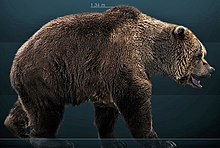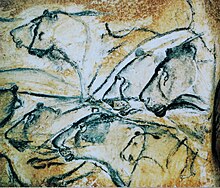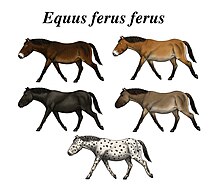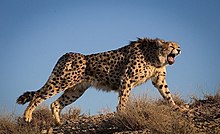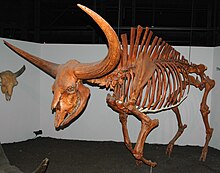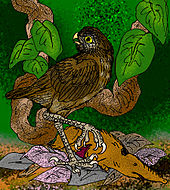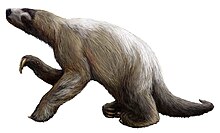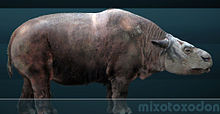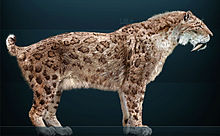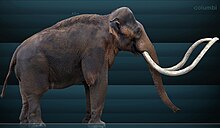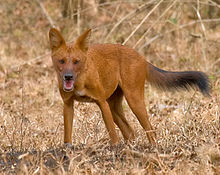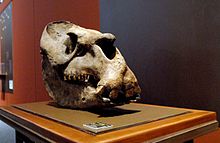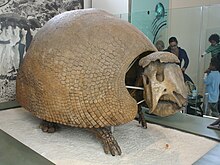Late Pleistocene landscape of northern Spain, by Mauricio Antón (left to right: Equus ferus, Mammuthus primigenius, Rangifer tarandus, Panthera spelaea, Coelodonta antiquitatis)
The Quaternary period (from 2.588 ± 0.005 million years ago to the present) saw the extinctions of numerous predominantly megafaunal
species, which resulted in a collapse in faunal density and diversity
and the extinction of key ecological strata across the globe. The most
prominent event in the Late Pleistocene is differentiated from previous Quaternary pulse extinctions by the widespread absence of ecological succession to replace these extinct species, and the regime shift of previously established faunal relationships and habitats as a consequence.
The earliest casualties were incurred at 130,000 BCE (the start of the Late Pleistocene). However, the great majority of extinctions in Afro-Eurasia and the Americas occurred during the transition from the Pleistocene to the Holocene
epoch (13,000 BCE to 8,000 BCE). This extinction wave did not stop at
the end of the Pleistocene, continuing, especially on isolated islands,
in human-caused extinctions, although there is debate as to whether these should be considered separate events or part of the same event.
Among the main causes hypothesized by paleontologists are overkill by the widespread appearance of humans and natural climate change. A notable modern human presence first appeared during the Middle Pleistocene in Africa, and started to establish continuous, permanent populations in Eurasia and Australasia from 120,000 BCE and 63,000 BCE respectively, and the Americas from 22,000 BCE.
A variant of the former possibility is the second-order predation
hypothesis, which focuses more on the indirect damage caused by
overcompetition with nonhuman predators. Recent studies have tended to
favor the human-overkill theory.
Extinctions by biogeographic realm
Introduction
A reconstruction of normative vegetation cover at the Last Glacial Maximum, circa 18,000 years ago, based on fossil pollen samples recovered from lake and bog sediments.
The Late Pleistocene extinction event saw the extinction of many
mammals weighing more than 40 kg. The proportional rate of megafauna
extinctions is progressively larger the greater the human migratory
distance from Africa.
The extinctions in the Americas
entailed the elimination of all the larger (over 100 kg) mammalian
species of South American origin, including those that had migrated
north in the Great American Interchange.
Only in the continents of Australia, North America, and South America
did the extinction occur at family taxonomic levels or higher.
The proportional rate of megafauna extinctions being
incrementally bigger the larger the migratory distance from Africa might
be related to non-African megafauna and Homo sapiens not having evolved as species alongside each other.
For their part, Australia, North America and South America, which
respectively had the highest incremental extinction rates, had no known
native species of Hominoidea (apes) at all, and specifically no species of Hominidae (greater apes) or Homo.
The increased rate of extinction mirrors the sequential pattern of the
migration of anatomically modern humans. The further away from Africa,
the more recently the area has been inhabited by humans, and the less
time the environments (including its megafauna) had had to become
accustomed to humans and vice versa.
There is no evidence of megafaunal extinctions at the height of the Last Glacial Maximum, indicating that increasing cold and glaciation were not factors. There are three main hypotheses concerning the Pleistocene extinction:
- climate change associated with the advance and retreat of major ice caps or ice sheets.
- "prehistoric overkill hypothesis"
- the extinction of the woolly mammoth changed the extensive grasslands to birch forests, and subsequent forest fires then changed the climate. We now know that immediately after the extinction of the mammoth, birch forests replaced the grasslands and that an era of significant fire began.
There are some inconsistencies between the current available data and
the prehistoric overkill hypothesis. For instance, there are
ambiguities around the timing of sudden extinctions of Australian megafauna. Biologists note that comparable extinctions have not occurred in Africa and South or Southeast Asia, where the fauna evolved with hominids. Post-glacial megafaunal extinctions in Africa have been spaced over a longer interval.
Evidence supporting the prehistoric overkill hypothesis includes
the persistence of certain island megafauna for several millennia past
the disappearance of their continental cousins. Ground sloths survived on the Antilles
long after North and South American ground sloths were extinct. The
later disappearance of the island species correlates with the later
colonization of these islands by humans. Similarly, woolly mammoths died
out on remote Wrangel Island 1,000 years after their extinction on the mainland. Steller's sea cows also persisted in seas off the isolated and uninhabited Commander Islands for thousands of years after they had vanished from the continental shores of the north Pacific.
Alternative hypotheses to the theory of human responsibility include climate change associated with the last glacial period and the Younger Dryas event, as well as Tollmann's hypothetical bolide, which claim that the extinctions resulted from bolide impact(s). Such a scenario has been proposed as a contributing cause of the 1,300-year cold period known as the Younger Dryas stadial.
This impact extinction hypothesis is still in debate due to the
exacting field techniques required to extract minuscule particles of
extraterrestrial impact markers such as iridium
at a high resolution from very thin strata in a repeatable fashion, as
is necessary to conclusively distinguish the event peak from the local
background level of the marker. The debate seems to be exacerbated by infighting between the Uniformitarianism camp and the Catastrophism camp.
Recent research indicates that each single species responded
differently to environmental changes, and that one factor by itself
cannot explain the large number of extinctions. The causes are complex,
and may involve elements of climate change, interspecific competition, unstable population dynamics, and human predation.
Afrotropic and Indomalaya: Africa and southern Asia
The Afrotropic and Indomalaya biogeographic realms, or Old World tropics, were relatively spared by the Late Pleistocene extinctions. Sub-Saharan Africa and southern Asia
are the only regions that have terrestrial mammals weighing over
1000 kg today. However, there are indications of megafaunal extinction
events throughout the Pleistocene, particularly in Africa two million
years ago, which coincide with key stages of human evolution and
climatic trends. The centre of human evolution and expansion, Africa and Asia were inhabited by advanced hominids by 2mya, with Homo habilis in Africa, and Homo erectus on both continents. By the advent and proliferation of Homo sapiens circa 315,000 BCE, dominant species included Homo heidelbergensis in Africa, the Denisovans and Neanderthals (fellow H. heidelbergensis descendants) in Eurasia, and Homo erectus
in Eastern Asia. Ultimately, on both continents, these groups and other
populations of Homo were subsumed by successive radiations of H. sapiens. There is evidence of an early migration event 268,000 BCE and later within Neanderthal genetics, however the earliest dating for H. sapiens inhabitation is 118,000 BCE in Arabia, China and Israel, and 71,000 BCE in Indonesia. Additionally, not only have these early Asian migrations left a genetic mark on modern Papuan populations, the oldest known pottery in existence was found in China, dated to 18,000 BCE.
Particularly during the late Pleistocene, megafaunal diversity was
notably reduced from both these continents, often without being replaced
by comparable successor fauna. Climate change has been explored as a prominent cause of extinctions in Southeast Asia.
Palearctic: Europe and northern Asia
The woolly mammoth became extinct around 10,000 BCE – except for diminutive relict populations on St. Paul Island and Wrangel Island, which humans did not colonise until 3,600 BCE and 2,000 BCE respectively.
Cave bear (Ursus spelaeus)
The 'Gallery of Lions', representations of the Eurasian Cave Lion in Chauvet-Pont-d'Arc Cave.
Models of the straight-tusked elephant (Paleoloxodon antiquus).
Elasmotherium reconstruction
Reconstruction of the five phenotypes of Pleistocene wild horse. The coat colours and dimensions are based on genetic evidence and historic descriptions.
Hippopotamuses (Hippopotamus sp.) inhabited Great Britain until 80,000 BCE, whence due to glacial shifts, hippopotamuses were restricted to Southern-Eastern Europe, Mediterranean islands and finally Western Asia until 1,000 BCE.
The leopard (Panthera pardus) inhabited the entire expanse of Afro-Eurasia below the 54th parallel north, from modern day Spain and the UK in the west, to South Africa in the south, and Siberia, Japan and Sundaland in the east during the Late Pleistocene.
Homotherium restoration.
A model of an adult Neanderthal male head and shoulders on display in the Hall of Human Origins in the National Museum of Natural History in Washington, D.C.
Modern cheetah (Acinonyx jubatus) replaced giant cheetah (Acinonyx pardinensis) in Eurasia after the Middle Pleistocene, and inhabited a range from Eastern Europe and the Balkans to China. Today, the critically endangered Eurasian cheetah are now restricted to Iran.
Saiga antelope (Saiga sp.) inhabited a range from England and France to the Yukon in the Late Pleistocene, diversifying into two species. S. borealis is now extinct and the critically endangered S. tatarica is now limited to steppe in Kazakhstan and Mongolia.
The Palearctic realm spans the entirety of the European continent, and stretches into Northern Asia, through the Caucasus and Central Asia to Northern China, Siberia and Beringia. During the Late Pleistocene, this region was noted for its great diversity and dynamism of biomes, including the warm climes of the Mediterranean basin, open temperate woodlands, arid plains, mountainous heathland and swampy wetlands,
all of which were vulnerable to the severe climatic fluctuations of the
interchanges between glacial and interglacials periods (stadials). However, it was the expansive mammoth steppe which was the ecosystem which united and defined this region during the Late Pleistocene. One of the key features of Europe's Late Pleistocene climate was the often drastic turnover of conditions and biota between the numerous stadials, which could set within a century. For example, during glacial periods, the entire North Sea was drained of water to form Doggerland. The final major cold spell occurred from 25,000 BCE to 18,000 BCE, and is known as the Last Glacial Maximum, when the Fenno-Scandinavian ice sheet covered much of northern Europe, while the Alpine ice sheet occupied significant parts of central-southern Europe.
Europe and northern Asia, being far colder and drier than today, was largely hegemonized by the mammoth steppe, an ecosystem dominated by palatable high-productivity grasses, herbs and willow shrubs. This supported an extensive biota of grassland fauna, and stretched eastwards from Spain in the Iberian Peninsula to the Yukon in modern-day Canada. The area was populated by many species of grazers
which assembled in large herds similar in size to those in Africa
today. Populous species which roamed the great grasslands included the woolly mammoth, woolly rhinoceros, Elasmotherium, steppe bison, Pleistocene horse, muskox, Cervalces, reindeer, antelope (Parabubalis, Procapra, Saiga, Spirocerus) and steppe pika. Carnivores included cave lion, Homotherium, cave hyena, grey wolf, dhole, and the arctic fox.
At the edges of these large stretches of grassland could be found more shrub-like terrain and dry conifer forests and woodland (akin to forest steppe or taiga). The browsing collective of megafauna included woolly rhinoceros, Giant deer, moose, Cervalces, tarpan, aurochs, woodland bison, camels and smaller deer (Capreolus, Cervus, Moschus). Brown bears, wolverines, cave bear, wolves, lynx, leopards, and red foxes also inhabited this biome. Tigers were at stages also present, from the edges of Eastern Europe around the Black Sea to Beringia. The more mountainous terrain, incorporating montane grasslands, subalpine conifer forests, alpine tundra and broken, craggy slopes, was occupied by several species of mountain-going animals like argali, chamois, ibex, mouflon, pika, wolves, leopards, Ursus sp. and lynx, with snow leopards, Baikal yak and snow sheep in Northern Asia. Arctic tundra, which lined the north of the mammoth steppe, reflected modern ecology with species such as the polar bear, wolf, reindeer and muskox.
Other biomes, although less noted, were significant in
contributing to the diversity of fauna in Late Pleistocene Europe.
Warmer grasslands such as temperate steppes and Mediterranean savannahs hosted Stephanorhinus, gazelle, European bison, Asian ostriches, Leptobos, cheetahs, and onager. These biomes also contained an assortment of mammoth steppe fauna, such as saiga antelope, lions, Homotherium, cave hyenas, wolves, Pleistocene horse, steppe bison, Spirocerus, aurochs, and camels. Temperate coniferous, deciduous, mixed broadleaf and Mediterranean forests and open woodlands accommodated straight-tusked elephants, Praemegaceros, Stephanorhinus, wild boar, bovids such as European bison, tahr and tur, species of Ursus such as the Etruscan bear, and smaller deer (Capreolus, Cervus, Dama, Haploidoceros) with several mammoth steppe species, such as lynx, tarpan, wolves, dholes, moose, Giant deer, woodland bison, leopards, and aurochs. Woolly rhinoceros and mammoth occasionally resided in these temperate biomes, mixing with predominately temperate fauna to escape harsh glacials. In warmer wetlands, European water buffalo and hippopotamus were present. Although these habitats were restricted to micro refugia and to Southern Europe and its fringes, being in Iberia, Italy, the Balkans, Ukraine's Black Sea basin, the Caucasus, and Western Asia, during inter-glacials these biomes had a far more northernly range. For example, hippopotamus inhabited Great Britain and straight-tusked elephant the Netherlands, as recently as 80,000 BCE and 42,000 BCE respectively.
The first possible indications of habitation by hominins are the 7.2 million year old finds of Graecopithecus,
and 5.7 million year old footprints in Crete — however established
habitation is noted in Georgia from 1.8 million years ago, proceeded to
Germany and France, by Homo erectus. Prominent co-current and subsequent species include Homo antecessor, Homo cepranensis, Homo heidelbergensis, Neanderthals and Denisovans,
preceding habitation by Homo sapiens circa 38,000 BCE. Extensive
contact between African and Eurasian Homo groups is known at least in
part through transfers of stone-tool technology in 500,000 BCE and again
at 250,000 BCE.
Europe's Late Pleistocene biota went through two phases of
extinction. Some fauna became extinct before 13,000 BCE, in staggered
intervals, particularly between 50,000 BCE and 30,000 BCE. Species
include cave bear, Elasmotherium, straight-tusked elephant, Stephanorhinus, water buffalo, Neanderthals, gazelle, and Homotherium. However, the great majority of species were extinguished, extirpated or experienced severe population contractions between 13,000 BCE and 9,000 BCE, ending with the Younger Dryas. At that time there were small ice sheets in Scotland and Scandinavia. The mammoth steppe disappeared from the vast majority of its former range, either due to a permanent shift in climatic conditions, or an absence of ecosystem management due to decimated, fragmented or extinct populations of megaherbivores. This led to a region wide extinction vortex, resulting in cyclically diminishing bio-productivity and defaunation. Insular species on Mediterranean islands such as Sardinia, Sicily, Malta, Cyprus and Crete, went extinct around the same time as humans colonised those islands. Fauna included dwarf elephantids, megacerines and hippopotamuses, and giant avians, otters and rodents.
Many species extant today were present in areas either far to the
south or west of their contemporary ranges- for example, all the arctic
fauna on this list inhabited regions as south as the Iberian Peninsula at various stages of the Late Pleistocene.
Nearctic: North America
Short-faced bear (Arctodus simus)
Californian flightless sea duck (Chendytes lawi)
Life restoration of the Yukon wild horse, Equus lambei.
Reconstruction of the Western Camel, Camelops hesternus
Life restoration of Cervalces scotti.
Bison latifrons, fossil bison skeleton (public display, Cincinnati Museum of Natural History & Science, Cincinnati, Ohio, US).
Californian Turkey (Meleagris californica) and Megafaunal Californian Condor (Gymnogyps amplus) fossil displays at La Brea Tar Pits.
Reconstruction of the Cuban Giant Owl, Ornimegalonyx oteroi, of Pleistocene Cuba, with the carcass of a large solenodon.
Life restoration of the Shasta Ground Sloth, Nothrotheriops shastensis.
Glyptotherium reconstruction
Mixotoxodon larenis reconstruction.
Reconstruction of Smilodon fatalis
Reconstruction of Panthera (leo) atrox
Columbian Mammoth (Mammuthus columbi) reconstruction
Graphical reconstruction of Mammut americanum.
The Dhole, now restricted to the southern portions of Asia, was present from Iberia to Mexico during the Late Pleistocene.
A Chacoan peccary (Catagonus wagneri), believed to be the closest surviving relative of the extinct Platygonus.
Size comparison of Smilodon fatalis (purple), S. popular (green), and S. gracilis (orange) with modern human for scale. Each grid segment=1 square meter.
Life restoration of Arctotherium bonariense.
Reconstruction of Canis dirus with two possible aspects according to its probable geographic origin: North American or South American.
Cuvieronius reconstruction
Reconstruction of a Macrauchenia mother and calf, from Pleistocene South America.
A Toxodon skull in an exhibition commemorating the 200th anniversary of Charles Darwin's birth, Esplanada dos Ministérios, Brasília
An illustration of Megatherium.
Doedicurus clavicaudatus reconstruction, distributed in the temperate savannahs and woodlands of South America.
Fossil reconstruction of Panochthus frenzelianus with metal model.
The disputed Late Pleistocene remains of a phorusrhacid in Uruguay are similar in size to the above Pliocene age Procariama simplex.
During the last 60,000 years, including the end of the last glacial period, approximately 51 genera of large mammals have become extinct in North America. Of these, many genera extinctions can be reliably attributed to a brief interval of 11,500 to 10,000 radiocarbon years before present, shortly following the arrival of the Clovis people in North America. Prominent paleontological sites include Mexico, and Panama, the crossroads of the American Interchange. Most other extinctions are poorly constrained in time, though some definitely occurred outside of this narrow interval.
In contrast, only about half a dozen small mammals disappeared during
this time. Previous North American extinction pulses had occurred at the
end of glaciations, but not with such an ecological imbalance between
large mammals and small ones. (Moreover, previous extinction pulses were
not comparable to the Quaternary extinction event; they involved
primarily species replacements within ecological niches, while the
latter event resulted in many ecological niches being left unoccupied.)
Such include the last native North American terror bird (Titanis), rhinoceros (Aphelops) and hyena (Chasmaporthetes). Human habitation commenced unequivacolly approximately 22,000 BCE north of the glacier, and 13,500 BCE south,
however disputed evidence of southern human habitation exists from
130,000 BCE and 17,000 BCE onwards, described from sites in California
and Meadowcroft in Pennsylvania. The megafaunal extinctions include forty one genera of herbivores (H), and twenty carnivores (C).
The survivors are in some ways as significant as the losses: bison (H), grey wolf (C), lynx (C), grizzly bear (C), American black bear (C), deer (e.g. caribou, moose, waipiti (elk), Odocoileus sp.) (H), pronghorn (H), white-lipped peccary (H), muskox (H), bighorn sheep (H), and mountain goat (H);
the list of survivors also include species which were extirpated during
the Quaternary extinction event, but recolonised at least part of their
ranges during the mid-holocene from South American relict populations,
such as the cougar (C), jaguar (C), giant anteater (C), collared peccary (H), ocelot (C), margay (C), and jaguarundi (C). All save the pronghorns and giant anteaters were descended from Asian ancestors that had evolved with human predators. Pronghorns are the second-fastest land mammal (after the cheetah),
which may have helped them elude hunters. More difficult to explain in
the context of overkill is the survival of bison, since these animals
first appeared in North America less than 240,000 years ago and so were
geographically removed from human predators for a sizeable period of
time.Because ancient bison evolved into living bison,
there was no continent-wide extinction of bison at the end of the
Pleistocene (although the genus was regionally extirpated in many
areas). The survival of bison into the Holocene and recent times is
therefore inconsistent with the overkill scenario. By the end of the
Pleistocene, when humans first entered North America, these large
animals had been geographically separated from intensive human hunting
for more than 200,000 years. Given this enormous span of geologic time,
bison would almost certainly have been very nearly as naive as native
North American large mammals.
The culture that has been connected with the wave of extinctions
in North America is the paleo-American culture associated with the Clovis people (q.v.), who were thought to use spear throwers
to kill large animals. The chief criticism of the "prehistoric overkill
hypothesis" has been that the human population at the time was too
small and/or not sufficiently widespread geographically to have been
capable of such ecologically significant impacts. This criticism does
not mean that climate change scenarios
explaining the extinction are automatically to be preferred by default,
however, any more than weaknesses in climate change arguments can be
taken as supporting overkill. Some form of a combination of both factors
could be plausible, and overkill would be a lot easier to achieve
large-scale extinction with an already dying population due to climate
change.
Lack of tameable megafauna was perhaps one of the reasons why Amerindian civilizations evolved differently from Old World ones. Critics have disputed this by arguing that llamas, alpacas, and bison were domesticated.
Neotropic: South America and the Caribbean
The Neotropic realm was affected by the fact that South America
had been isolated as an island continent for many millions of years,
and had a wide range of fauna found nowhere else, although many of them
became extinct during the Great American Interchange about 3 million years ago, such as the Sparassodonta family. Those that survived the interchange included the ground sloths, glyptodonts, litopterns, pampatheres, phorusrhacids (terror birds) and notoungulates; all managed to extend their range to North America. In the Pleistocene, South America remained largely unglaciated except for increased mountain glaciation in the Andes, which had a two-fold effect- there was a faunal divide between the Andes,
and the colder, arid interior resulted in the advance of temperate
lowland woodlands, tropical savannas and deserts at the expense of
rainforests.
Within these open environments, megafauna diversity was extremely
dense, with over 40 genera recorded from the Guerrero member of Luján Formation alone. Ultimately, by the mid-Holocene, all the preeminent genera of megafauna became extinct- the last specimens of Doedicurus and Toxodon have been dated to 4,555 BCE and 3,000 BCE respectively. Their smaller relatives remain, including anteaters, tree sloths, armadillos; New World marsupials: opossums, shrew opossums, and the monito del monte (actually more related to Australian marsupials). Intense human habitation was established circa 11,000 BCE, however partly disputed evidence of pre-clovis habitation occurs since 46,000 BCE and 20,000 BCE, such as at the Serra da Capivara National Park (Brazil) and Monte Verde (Chile) sites. Today the largest land mammals remaining in South America are the wild camels of the Lamini group, such as the guanacos and vicuñas, and the Tapirus genus, of which Baird's tapir can reach up to 400 kg. Other notable surviving large fauna are peccaries, marsh deer (Capreolinae), giant anteaters, spectacled bears, maned wolves, pumas, ocelots, jaguars, rheas, emerald tree boas, boa constrictors, anacondas, American crocodiles, caimans, and giant rodents such as capybaras.
The Pacific (Australasia and Oceania)
Procoptodon goliath reconstruction
Thylacoleo carnifex rock art
Megalania priscus skeleton, Melbourne Museum
Reconstruction of the Late Pleistocene mekosuchine crocodile, Mekosuchus inexpectans, of prehistoric Fiji.
Reconstruction of the extinct Giant Fijian Iguana, Lapitiguana impensa, and two Viti Levu Giant Pigeons, Natunaornis gigoura, from prehistoric Fiji.
AuThe American flamingo (Phoenicopterus ruber) was one of four species of flamingo present in Australia in the Quaternary, all of which are now either extinct or extirpated. Australia is now the only inhabited continent in the world without flamingoes.
In Sahul (a former continent composed of Australia and New Guinea), the sudden and extensive spate of extinctions occurred earlier than in the rest of the world. Most evidence points to a 20,000 year period after human arrival circa 63,000 BCE, but scientific argument continues as to the exact date range. In the rest of the Pacific (other Australasian islands such as New Caledonia, and Oceania)
although in some respects far later, endemic fauna also usually
perished quickly upon the arrival of humans in the late Pleistocene and
early Holocene. This section does not include any spate of extinctions
post 1000 BCE (e.g. subatlantic New Zealand or Hawaii).
Some extinct megafauna, such as the bunyip-like Diprotodon, may remain in folk memory or be the sources of cryptozoological legends.
Relationship to later extinctions
There is no general agreement on where the Holocene, or anthropogenic, extinction begins, and the Quaternary extinction event ends, or if they should be considered separate events at all.
Some have suggested that anthropogenic extinctions may have begun as
early as when the first modern humans spread out of Africa between
100,000 and 200,000 years ago, which is supported by rapid megafaunal
extinction following recent human colonisation in Australia, New Zealand and Madagascar, in a similar way that any large, adaptable predator moving into a new ecosystem would. In many cases, it is suggested even minimal hunting pressure was enough to wipe out large fauna, particularly on geographically isolated islands. Only during the most recent parts of the extinction have plants also suffered large losses.
Overall, the Holocene extinction can be characterised by the human impact on the environment. The Holocene extinction continues into the 21st century, with overfishing, ocean acidification and the amphibian crisis being a few broader examples of an almost universal, cosmopolitan decline of biodiversity.
Hunting hypothesis
A woolly mammoth hunt
The earliest finds of Homo sapiens point to an emergence during the Middle Pleistocene
of Africa. However, there is evidence of extinction waves, particularly
of megafaunal carnivores, coinciding with both cranial and
technological developments within ancestral Homo during the Early Pleistocene of Africa. This has suggested a human role in these ecological cascades. H. sapiens skull described from Jebel Irhoud, Morocco, dated to 315,000 BCE.
Despeciation within the genus Homo.
Known H. sapiens migration routes in the Pleistocene.
The hunting hypothesis suggests that humans hunted megaherbivores to extinction, which in turn caused the extinction of carnivores and scavengers which had preyed upon those animals. Therefore, this hypothesis holds Pleistocene humans responsible for the megafaunal extinction. One variant, known as blitzkrieg,
portrays this process as relatively quick. Some of the direct evidence
for this includes: fossils of some megafauna found in conjunction with
human remains, embedded arrows and tool cut marks found in megafaunal
bones, and European cave paintings that depict such hunting. Biogeographical
evidence is also suggestive: the areas of the world where humans
evolved currently have more of their Pleistocene megafaunal diversity
(the elephants and rhinos of Asia and Africa) compared to other areas such as Australia, the Americas, Madagascar and New Zealand
without the earliest humans. A picture arises of the megafauna of Asia
and Africa evolving alongside humans, learning to be wary of them, and
in other parts of the world the wildlife appearing ecologically naive and easier to hunt. This is particularly true of island fauna, which display a disastrous lack of fear of humans. Of course, it is impossible to demonstrate this naïveté directly in ancient fauna.
Circumstantially, the close correlation in time between the
appearance of humans in an area and extinction there provides weight for
this scenario. The megafaunal extinctions covered a vast period of time
and highly variable climatic situations. The earliest extinctions in
Australia were complete approximately 50,000 BP, well before the last
glacial maximum and before rises in temperature. The most recent
extinction in New Zealand was complete no earlier than 500 BP and during
a period of cooling. In between these extremes megafaunal extinctions
have occurred progressively in such places as North America, South
America and Madagascar with no climatic commonality. The only common
factor that can be ascertained is the arrival of humans.
This phenomenon appears even within regions. The mammal extinction wave
in Australia about 50,000 years ago coincides not with known climatic
changes, but with the arrival of humans. In addition, large mammal
species like the giant kangaroo Protemnodon
appear to have succumbed sooner on the Australian mainland than on
Tasmania, which was colonised by humans a few thousand years later.
Worldwide, extinctions seem to follow the migration of humans and
to be most severe where humans arrived most recently and least severe
where humans originated — in Africa (see figure "March of Man" below).
This suggests that prey animals and human hunting ability evolved
together, so the animals evolved avoidance techniques. As humans
migrated throughout the world and became more and more proficient at
hunting, they encountered animals that had evolved without the presence
of humans. Lacking the fear of humans that African animals had
developed, animals outside of Africa were easy prey for human hunting
techniques. It also suggests that this is independent of climate change.
Extinction through human hunting has been supported by archaeological finds of mammoths with projectile points embedded in their skeletons, by observations of modern naïve animals allowing hunters to approach easily and by computer models by Mosimann and Martin, and Whittington and Dyke, and most recently by Alroy.
A study published in 2015 supported the hypothesis further by
running several thousand scenarios that correlated the time windows in
which each species is known to have become extinct with the arrival of
humans on different continents or islands. This was compared against climate reconstructions for the last 90,000 years. The researchers found correlations of human spread and species extinction indicating that the human impact was the main cause of the extinction, while climate change exacerbated the frequency of extinctions. The study, however, found an apparently low extinction rate in the fossil record of mainland Asia.
Overkill hypothesis
The timing of extinctions follows the "March of Man"
The overkill hypothesis, a variant of the hunting hypothesis, was proposed in 1966 by Paul S. Martin, Professor of Geosciences Emeritus at the Desert Laboratory of the University of Arizona.
Objections to the hunting hypothesis
The major objections to the theory are as follows:
- In predator-prey models it is unlikely that predators could over-hunt their prey, since predators need their prey as food to sustain life and to reproduce. This assumes that all food sources die out simultaneously, but humans could have made the mammoth extinct while subsiding on elk, for example. Human hunting is known to have exterminated megafauna on several islands, switching to other food sources with time or dying out themselves. Additionally it is common knowledge among ornithologists that introduced predators have easily made several species extinct on islands, and this is a foremost cause of island extinctions today.
- There is no archeological evidence that in North America megafauna other than mammoths, mastodons, gomphotheres and bison were hunted, despite the fact that, for example, camels and horses are very frequently reported in fossil history. Overkill proponents, however, say this is due to the fast extinction process in North America and the low probability of animals with signs of butchery to be preserved. Additionally, biochemical analyses have shown that Clovis tools were used in butchering horses and camels. A study by Surovell and Grund concluded "archaeological sites dating to the time of the coexistence of humans and extinct fauna are rare. Those that preserve bone are considerably more rare, and of those, only a very few show unambiguous evidence of human hunting of any type of prey whatsoever."
- A small number of animals that were hunted, such as a single species of bison, did not go extinct. This cannot be explained by proposing that surviving bison in North America were recent Eurasian immigrants that were familiar with human hunting practices, since Bison first appeared in North America approximately 240,000 years ago and then evolved into living bison. Bison at the end of the Pleistocene were thus likely to have been almost as naive as their native North American megafaunal companions.
- The dwarfing of animals is not explained by overkill. Numerous authors, however, have pointed out that dwarfing of animals is perfectly well explained by humans selectively harvesting the largest animals, and have provided proof that even within the 20th century numerous animal populations have reduced in average size due to human hunting.
- Eurasian Pleistocene megafauna became extinct in roughly same time period despite having a much longer time to adapt to hunting pressure by humans. However, the extinction of the Eurasian megafauna can be viewed as a result of a different process than that of the American megafauna. This makes the theory less parsimonious since another mechanism is required. The latter case occurred after the sudden appearance of modern human hunters on a land mass they had never previously inhabited, while the former case was the culmination of the gradual northward movement of human hunters over thousands of years as their technology for enduring extreme cold and bringing down big game improved. Thus, while the hunting hypothesis does not necessarily predict the rough simultaneity of the north Eurasian and American megafaunal extinctions, this simultaneity cannot be regarded as evidence against it.
- Eugene S. Hunn points out that the birthrate in hunter-gatherer societies is generally too low, that too much effort is involved in the bringing down of a large animal by a hunting party, and that in order for hunter-gatherers to have brought about the extinction of megafauna simply by hunting them to death, an extraordinary amount of meat would have had to have been wasted. It is possible that those who advocate the overkill hypothesis simply have not considered the differences in outlook between typical forager (hunter-gatherer) cultures and the present-day industrial cultures which exist in modernized human societies; waste may be tolerated and even encouraged in the latter, but is not so much in the former. It may be noted that in relatively recent human history, for instance, the Lakota of North America were known to take only as much bison as they could use, and they used virtually the whole animal—this despite having access to herds numbering in the millions. Conversely, "buffalo jumps" featured indiscriminate killing of a herd. However, Hunn's comments are in reference to the now largely discredited theory of hunter-prey equilibrium reached after thousands of years of coexistence. It is not relevant to hunters newly arrived on a virgin land mass full of easily taken big game. The well-established practice of industrial-scale moa butchering by the early Maori, involving enormous wastage of less choice portions of the meat, indicates that these arguments are incorrect.
- The hypothesis that the Clovis culture represented the first humans to arrive in the New World has been disputed recently. (See Settlement of the Americas.) However, they were certainly the first to leave abundant widespread evidence of their presence.
Climate change hypothesis
At the end of the 19th and beginning of the 20th centuries, when scientists first realized that there had been glacial and interglacial
ages, and that they were somehow associated with the prevalence or
disappearance of certain animals, they surmised that the termination of
the Pleistocene ice age might be an explanation for the extinctions.
Critics object that since there were multiple glacial advances and withdrawals
in the evolutionary history of many of the megafauna, it is rather
implausible that only after the last glacial maximum would there be such
extinctions. However, this criticism is rejected by a recent study
indicating that terminal Pleistocene megafaunal community composition
may have differed markedly from faunas present during earlier
interglacials, particularly with respect to the great abundance and
geographic extent of Pleistocene Bison at the end of the epoch.
This suggests that the survival of megafaunal populations during
earlier interglacials is essentially irrelevant to the terminal
Pleistocene extinction event, because bison were not present in similar
abundance during any of the earlier interglacials.
Some evidence weighs against climate change as a valid hypothesis
as applied to Australia. It has been shown that the prevailing climate
at the time of extinction (40,000–50,000 BP) was similar to that of
today, and that the extinct animals were strongly adapted to an arid
climate. The evidence indicates that all of the extinctions took place
in the same short time period, which was the time when humans entered
the landscape. The main mechanism for extinction was probably fire
(started by humans) in a then much less fire-adapted landscape. Isotopic
evidence shows sudden changes in the diet of surviving species, which
could correspond to the stress they experienced before extinction.
Evidence in Southeast Asia, in contrast to Europe, Australia, and
the Americas, suggests that climate change and an increasing sea level
were significant factors in the extinction of several herbivorous
species. Alterations in vegetation growth and new access routes for
early humans and mammals to previously isolated, localized ecosystems
were detrimental to select groups of fauna.
Some evidence obtained from analysis of the tusks of mastodons from the American Great Lakes region
appears inconsistent with the climate change hypothesis. Over a span of
several thousand years prior to their extinction in the area, the
mastodons show a trend of declining age at maturation. This is the
opposite of what one would expect if they were experiencing stresses
from deteriorating environmental conditions, but is consistent with a
reduction in intraspecific competition that would result from a
population being reduced by human hunting.
Increased temperature
The most obvious change associated with the termination of an ice age is the increase in temperature. Between 15,000 BP
and 10,000 BP, a 6 °C increase in global mean annual temperatures
occurred. This was generally thought to be the cause of the extinctions.
According to this hypothesis, a temperature increase sufficient to melt the Wisconsin ice sheet
could have placed enough thermal stress on cold-adapted mammals to
cause them to die. Their heavy fur, which helps conserve body heat in
the glacial cold, might have prevented the dumping of excess heat,
causing the mammals to die of heat exhaustion. Large mammals, with their
reduced surface area-to-volume ratio, would have fared worse than small mammals.
A study covering the past 56,000 years indicates that rapid
warming events with temperature changes of up to 16 °C (29 °F) had an
important impact on the extinction of megafauna. Ancient DNA and
radiocarbon data indicates that local genetic populations were replaced
by others within the same species or by others within the same genus.
Survival of populations was dependent on the existence of refugia and long distance dispersals, which may have been disrupted by human hunters.
Arguments against the temperature hypothesis
Studies
propose that the annual mean temperature of the current interglacial
that we have seen for the last 10,000 years is no higher than that of
previous interglacials, yet some of the same large mammals survived
similar temperature increases. Therefore, warmer temperatures alone may
not be a sufficient explanation.
In addition, numerous species such as mammoths on Wrangel Island and St. Paul Island survived in human-free refugia
despite changes in climate. This would not be expected if climate
change were responsible (unless their maritime climates offered some
protection against climate change not afforded to coastal populations on
the mainland). Under normal ecological assumptions island populations
should be more vulnerable to extinction due to climate change because of
small populations and an inability to migrate to more favorable climes.
Increased continentality affects vegetation in time or space
Other scientists have proposed that increasingly extreme weather—hotter summers and colder winters—referred to as "continentality", or related changes in rainfall caused the extinctions. The various hypotheses are outlined below.
Vegetation changes: geographic
It has been shown that vegetation changed from mixed woodland-parkland to separate prairie and woodland.
This may have affected the kinds of food available. Shorter growing
seasons may have caused the extinction of large herbivores and the
dwarfing of many others. In this case, as observed, bison and other
large ruminants would have fared better than horses, elephants and other monogastrics, because ruminants are able to extract more nutrition from limited quantities of high-fiber food and better able to deal with anti-herbivory toxins.
So, in general, when vegetation becomes more specialized, herbivores
with less diet flexibility may be less able to find the mix of
vegetation they need to sustain life and reproduce, within a given area.
Rainfall changes: time
Increased
continentality resulted in reduced and less predictable rainfall
limiting the availability of plants necessary for energy and nutrition. Axelrod and Slaughter
have suggested that this change in rainfall restricted the amount of
time favorable for reproduction. This could disproportionately harm
large animals, since they have longer, more inflexible mating periods,
and so may have produced young at unfavorable seasons (i.e., when
sufficient food, water, or shelter was unavailable because of shifts in
the growing season). In contrast, small mammals, with their shorter life cycles, shorter reproductive cycles, and shorter gestation
periods, could have adjusted to the increased unpredictability of the
climate, both as individuals and as species which allowed them to
synchronize their reproductive efforts with conditions favorable for
offspring survival. If so, smaller mammals would have lost fewer
offspring and would have been better able to repeat the reproductive
effort when circumstances once more favored offspring survival.
In 2017 a study looked at the environmental conditions across
Europe, Siberia and the Americas from 25,000–10,000 YBP. The study found
that prolonged warming events leading to deglaciation and maximum
rainfall occurred just prior to the transformation of the rangelands
that supported megaherbivores into widespread wetlands that supported
herbivore-resistant plants. The study proposes that moisture-driven
environmental change led to the megafaunal extinctions and that Africa's
trans-equatorial position allowed rangeland to continue to exist
between the deserts and the central forests, therefore fewer megafauna
species became extinct there.
Arguments against the continentality hypotheses
Critics have identified a number of problems with the continentality hypotheses.
- Megaherbivores have prospered at other times of continental climate. For example, megaherbivores thrived in Pleistocene Siberia, which had and has a more continental climate than Pleistocene or modern (post-Pleistocene, interglacial) North America.
- The animals that became extinct actually should have prospered during the shift from mixed woodland-parkland to prairie, because their primary food source, grass, was increasing rather than decreasing. Although the vegetation did become more spatially specialized, the amount of prairie and grass available increased, which would have been good for horses and for mammoths, and yet they became extinct. This criticism ignores the increased abundance and broad geographic extent of Pleistocene Bison at the end of the Pleistocene, which would have increased competition for these resources in a manner not seen in any earlier interglacials.
- Although horses became extinct in the New World, they were successfully reintroduced by the Spanish in the 16th century—into a modern post-Pleistocene, interglacial climate. Today there are feral horses still living in those same environments. They find a sufficient mix of food to avoid toxins, they extract enough nutrition from forage to reproduce effectively and the timing of their gestation is not an issue. Of course, this criticism ignores the obvious fact that present-day horses are not competing for resources with ground sloths, mammoths, mastodons, camels, llamas, and bison. Similarly, mammoths survived the Pleistocene Holocene transition on isolated, uninhabited islands in the Mediterranean Sea and on Wrangel Island in the Siberian Arctic until 4,000 to 7,000 years ago.
- Large mammals should have been able to migrate, permanently or seasonally, if they found the temperature too extreme, the breeding season too short, or the rainfall too sparse or unpredictable. Seasons vary geographically. By migrating away from the equator, herbivores could have found areas with growing seasons more favorable for finding food and breeding successfully. Modern-day African elephants migrate during periods of drought to places where there is apt to be water.
- Large animals store more fat in their bodies than do medium-sized animals and this should have allowed them to compensate for extreme seasonal fluctuations in food availability.
The extinction of the megafauna could have caused the disappearance of the mammoth steppe.
Alaska now has low nutrient soil unable to support bison, mammoths, and
horses. R. Dale Guthrie has claimed this as a cause of the extinction
of the megafauna there; however, he may be interpreting it backwards.
The loss of large herbivores to break up the permafrost allows the cold
soils that are unable to support large herbivores today. Today, in the
arctic, where trucks have broken the permafrost grasses and diverse
flora and fauna can be supported.
In addition, Chapin (Chapin 1980) showed that simply adding fertilizer
to the soil in Alaska could make grasses grow again like they did in the
era of the mammoth steppe. Possibly, the extinction of the megafauna
and the corresponding loss of dung is what led to low nutrient levels in
modern-day soil and therefore is why the landscape can no longer
support megafauna.
Arguments against both climate change and overkill
It may be observed that neither the overkill nor the climate change hypotheses can fully explain events: browsers, mixed feeders and non-ruminant grazer species suffered most, while relatively more ruminant grazers survived.
However, a broader variation of the overkill hypothesis may predict
this, because changes in vegetation wrought by either Second Order
Predation (see below) or anthropogenic fire preferentially selects against browse species.
Hyperdisease hypothesis
Theory
The
hyperdisease hypothesis attributes the extinction of large mammals
during the late Pleistocene to indirect effects of the newly arrived aboriginal humans.
The Hyperdisease Hypothesis proposes that humans or animals traveling
with them (e.g., chickens or domestic dogs) introduced one or more
highly virulent
diseases into vulnerable populations of native mammals, eventually
causing extinctions. The extinction was biased toward larger-sized
species because smaller species have greater resilience because of their
life history traits (e.g., shorter gestation time, greater population
sizes, etc.). Humans are thought to be the cause because other earlier
immigrations of mammals into North America from Eurasia did not cause
extinctions.
Diseases imported by people have been responsible for extinctions in the recent past; for example, bringing avian malaria to Hawaii has had a major impact on the isolated birds of the island.
If a disease was indeed responsible for the end-Pleistocene
extinctions, then there are several criteria it must satisfy (see Table
7.3 in MacPhee & Marx 1997). First, the pathogen must have a stable carrier state in a reservoir species. That is, it must be able to sustain itself in the environment when there are no susceptible hosts
available to infect. Second, the pathogen must have a high infection
rate, such that it is able to infect virtually all individuals of all
ages and sexes encountered. Third, it must be extremely lethal, with a
mortality rate of c. 50–75%. Finally, it must have the ability to infect
multiple host species without posing a serious threat to humans. Humans
may be infected, but the disease must not be highly lethal or able to
cause an epidemic.
One suggestion is that pathogens were transmitted by the expanding humans via the domesticated dogs they brought with them.
Unfortunately for such a theory it can not account for several major
extinction events, notably Australia and North America. Dogs did not
arrive in Australia until approximately 35,000 years after the first
humans arrived and approximately 30,000 years after the megafaunal
extinction was complete and as such can not be implicated. In contrast
numerous species including wolves, mammoths, camelids and horses had
emigrated continually between Asia and North America over the past
100,000 years. For the disease hypothesis to be applicable in the case
of the Americas it would require that the population remain
immunologically naive despite this constant transmission of genetic and
pathogenic material.
Arguments against the hyperdisease hypothesis
- Generally speaking, disease has to be very virulent to kill off all the individuals in a genus or species. Even such a virulent disease as West Nile fever is unlikely to have caused extinction.
- The disease would need to be implausibly selective while being simultaneously implausibly broad. Such a disease needs to be capable of killing off wolves such as Canis dirus or goats such as Oreamnos harringtoni while leaving other very similar species (Canis lupus and Oreamnos americanus, respectively) unaffected. It would need to be capable of killing off flightless birds while leaving closely related flighted species unaffected. Yet while remaining sufficiently selective to afflict only individual species within genera it must be capable of fatally infecting across such clades as birds, marsupials, placentals, testudines, and crocodilians. No disease with such a broad scope of fatal infectivity is known, much less one that remains simultaneously incapable of infecting numerous closely related species within those disparate clades.
Second-order predation hypothesis
Combination Hypotheses: Climate Change, Overkill + Climate Change, Second-Order Predation + Climate Change
Overkill Hypothesis and Second-Order Predation
Scenario
The
Second-Order Predation Hypothesis says that as humans entered the New
World they continued their policy of killing predators, which had been
successful in the Old World but because they were more efficient and
because the fauna, both herbivores and carnivores, were more naive, they
killed off enough carnivores to upset the ecological balance of the continent, causing overpopulation,
environmental exhaustion, and environmental collapse. The hypothesis
accounts for changes in animal, plant, and human populations.
The scenario is as follows:
- After the arrival of H. sapiens in the New World, existing predators must share the prey populations with this new predator. Because of this competition, populations of original, or first-order, predators cannot find enough food; they are in direct competition with humans.
- Second-order predation begins as humans begin to kill predators.
- Prey populations are no longer well controlled by predation. Killing of nonhuman predators by H. sapiens reduces their numbers to a point where these predators no longer regulate the size of the prey populations.
- Lack of regulation by first-order predators triggers boom-and-bust cycles in prey populations. Prey populations expand and consequently overgraze and over-browse the land. Soon the environment is no longer able to support them. As a result, many herbivores starve. Species that rely on the slowest recruiting food become extinct, followed by species that cannot extract the maximum benefit from every bit of their food.
- Boom-bust cycles in herbivore populations change the nature of the vegetative environment, with consequent climatic impacts on relative humidity and continentality. Through overgrazing and overbrowsing, mixed parkland becomes grassland, and climatic continentality increases.
Support
This
has been supported by a computer model, the Pleistocene Extinction Model
(PEM), which, using the same assumptions and values for all variables
(herbivore population, herbivore recruitment rates, food needed per
human, herbivore hunting rates, etc.) other than those for hunting of
predators. It compares the Overkill hypothesis (predator hunting = 0)
with Second-Order Predation (predator hunting varied between 0.01 and
0.05 for different runs). The findings are that Second Order-Predation
is more consistent with extinction than is Overkill (results graph at left).
The PEM is the only test of multiple hypotheses and is the only
model to specifically test combination hypotheses by artificially
introducing sufficient climate change to cause extinction. When Overkill
and Climate Change are combined they balance each other out. Climate
Change reduces the number of plants, Overkill removes animals, therefore
fewer plants are eaten. Second-Order Predation combined with Climate
Change exacerbates the effect of Climate Change. (results graph at right).
The second-order predation hypothesis is supported by the
observation above that there was a massive increase in bison
populations.
Second-order predation and other theories
- Climate Change: Second-Order Predation accounts for the changes in vegetation, which in turn may account for the increase in continentality. Since the extinction is due to destruction of habitat it accounts for the loss of animals not hunted by humans. Second-Order Predation accounts for the dwarfing of animals as well as extinctions since animals that could survive and reproduce on less food would be selectively favored.
- Hyperdisease: The reduction of carnivores could have been from distemper or other carnivore disease carried by domestic dogs.
- Overkill: The observation that extinctions follow the arrival of humans is consistent with the Second-Order Predation hypothesis.
Arguments against the second-order predation hypothesis
- The model specifically assumes high extinction rates in grasslands, but most extinct species ranged across numerous vegetation zones. Historical population densities of ungulates were very high in the Great Plains; savanna environments support high ungulate diversity throughout Africa, and extinction intensity was equally severe in forested environments.
- It is unable to explain why large herbivore populations were not regulated by surviving carnivores such as grizzly bears, wolves, pumas, and jaguars whose populations would have increased rapidly in response to the loss of competitors.
- It does not explain why almost all extinct carnivores were large herbivore specialists such as sabre toothed cats and short faced bears, but most hypocarnivores and generalized carnivores survived.
- There is no historical evidence of boom and bust cycles causing even local extinctions in regions where large mammal predators have been driven extinct by hunting. The recent hunting out of remaining predators throughout most of the United States has not caused massive vegetational change or dramatic boom and bust cycles in ungulates.
- It is not spatially explicit and does not track predator and prey species separately, whereas the multispecies overkill model does both.
- The multispecies model produces a mass extinction through indirect competition between herbivore species: small species with high reproductive rates subsidize predation on large species with low reproductive rates. All prey species are lumped in the Pleistocene Extinction Model.
- Everything explained by the Pleistocene Extinction Model also is explained by the multispecies model, but with fewer assumptions, so the Pleistocene Extinction Model appears less parsimonious. However, the multispecies model does not explain shifts in vegetation, nor is it able to simulate alternative hypotheses. The multispecies model therefore necessitates additional assumptions and hence is less parsimonious.
Arguments against the second-order predation plus climate hypothesis
- It assumes decreases in vegetation due to climate change, but deglaciation doubled the habitable area of North America.
- Any vegetational changes that did occur failed to cause almost any extinctions of small vertebrates, and they are more narrowly distributed on average.
Comet hypothesis
First publicly presented at the Spring 2007 joint assembly of the American Geophysical Union in Acapulco, Mexico, the comet hypothesis suggests that the mass extinction was caused by a swarm of comets 12,900 years ago. Using photomicrograph analysis, research published in January 2009 has found evidence of nanodiamonds
in the soil from six sites across North America including Arizona,
Minnesota, Oklahoma, South Carolina and two Canadian sites. Similar
research found nanodiamonds in the Greenland ice sheet.
Arguments against/for the comet hypothesis
Debate
around this hypothesis has included, among other things, the lack of an
impact crater, relatively small increased level of iridium
in the soil, and the relative probability of such an event. That said,
it took 10 years after publication of the Alvarez theory before
scientists found the Chicxulub crater.
If the bolide struck the Laurentide ice sheet as hypothesized by
Firestone et al. (2007), we would not see the typical impact crater.
A spike in platinum was found in the Greenland ice cores by Petaev et al. (2013), which they view as a global signal.
Confirmation came in 2017 with the report that the Pt spike had been
found at "11 widely separated archaeological bulk sedimentary
sequences."
Wolbach et al. reported in 2018 that "YDB peaks in Pt were observed at
28 sites" in total, including the 11 reported earlier and the one from
Greenland.
- Some have reported a lack of evidence for a population decline among the Paleoindians at 12,900 ± 100 calBP. However, others have reported finding such evidence.
- There is evidence that the megafaunal extinctions that occurred across northern Eurasia, North America and South America at the end of the Pleistocene were not synchronous as the bolide theory would predict. The extinctions in South America appear to have occurred at least 400 years after those in North America.
- Additionally, some island megafaunal populations survived thousands of years longer than populations of the same or related species on nearby continents; examples include the survival of woolly mammoths on Wrangel Island until 3700 BP, and the survival of ground sloths in the Antilles until 4700 cal BP.
- Several markers for the proposed impact event are disputed. Opponents have asserted that the carbon spherules originated as fungal structures and/or insect fecal pellets, and that the claimed nanodiamonds are actually misidentified graphene and graphene/graphane oxide aggregates. An analysis of a similar Younger Dryas boundary layer in Belgium also did not show evidence of a bolide impact.
- However, proponents of the hypothesis have responded to defend their results, disputing the accusation of irreproducibility and/or replicating their findings. Prior to finding of a widespread Pt spike on the continents, Pleistocene expert Wallace Broecker had already changed his mind about the YDIH: "The Greenland platinum peak makes clear that an extraterrestrial impact occurred close to the onset of the YD."



